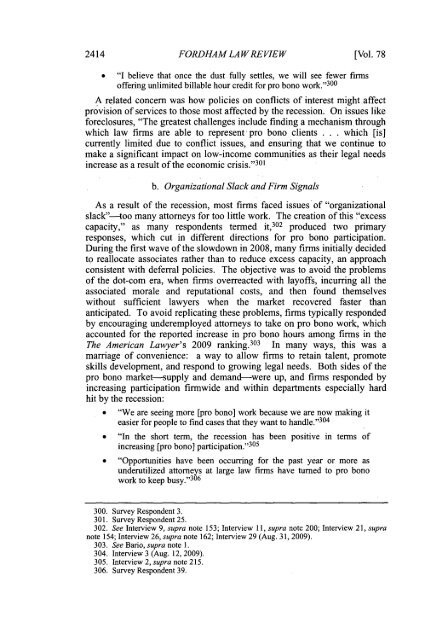Law for The Poor
Law for The Poor
Law for The Poor
Create successful ePaper yourself
Turn your PDF publications into a flip-book with our unique Google optimized e-Paper software.
2414 FORDHAM LA W REVIEW<br />
[Vol. 78<br />
* "I believe that once the dust fully settles, we will see fewer firms<br />
offering unlimited billable hour credit <strong>for</strong> pro bono work." 300<br />
A related concern was how policies on conflicts of interest might affect<br />
provision of services to those most affected by the recession. On issues like<br />
<strong>for</strong>eclosures, "<strong>The</strong> greatest challenges include finding a mechanism through<br />
which law firms are able to represent, pro bono clients . . . which [is]<br />
currently limited due to conflict issues, and ensuring that we continue to<br />
make a significant impact on low-income communities as their legal needs<br />
increase as a result of the economic crisis." 30 1<br />
b. Organizational Slack and Firm Signals<br />
As a result of the recession, most firms faced issues of "organizational<br />
slack"--too many attorneys <strong>for</strong> too little work. <strong>The</strong> creation of this "excess<br />
capacity," as many respondents termed it, 302 produced two primary<br />
responses, which cut in different directions <strong>for</strong> pro bono participation.<br />
During the first wave of the slowdown in 2008, many firms initially decided<br />
to reallocate associates rather than to reduce excess capacity, an approach<br />
consistent with deferral policies. <strong>The</strong> objective was to avoid the problems<br />
of the dot-com era, when firms overreacted with layoffs, incurring all the<br />
associated morale and reputational costs, and then found themselves<br />
without sufficient lawyers when the market recovered faster than<br />
anticipated. To avoid replicating these problems, firms typically responded<br />
by encouraging underemployed attorneys to take on pro bono work, which<br />
accounted <strong>for</strong> the reported increase in pro bono hours among firms in the<br />
<strong>The</strong> American <strong>Law</strong>yer's 2009 ranking. 30 3 In many ways, this was a<br />
marriage of convenience: a way to allow firms to retain talent, promote<br />
skills development, and respond to growing legal needs. Both sides of the<br />
pro bono market--supply and demand-were up, and firms responded by<br />
increasing participation firmwide and within departments especially hard<br />
hit by the recession:<br />
* "We are seeing more [pro bono] work because we are now making it<br />
easier <strong>for</strong> people to find cases that they want to handle." 30 4<br />
" "In the short term, the recession has been positive in terms of<br />
increasing [pro bono] participation. " ' 30 5<br />
* "Opportunities have been occurring <strong>for</strong> the past year or more as<br />
underutilized attorneys at large law firms have turned to pro bono<br />
work to keep busy." 306<br />
300. Survey Respondent 3.<br />
301. Survey Respondent 25.<br />
302. See Interview 9, supra note 153; Interview 11, supra note 200; Interview 21, supra<br />
note 154; Interview 26, supra note 162; Interview 29 (Aug. 31, 2009).<br />
303. See Bario, supra note 1.<br />
304. Interview 3 (Aug. 12, 2009).<br />
305. Interview 2, supra note 215.<br />
306. Survey Respondent 39.

















